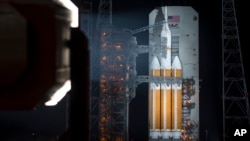Thursday's scheduled launch of a new spacecraft intended to take U.S. astronauts back to the moon and beyond has been delayed for at least a day.
A variety of problems halted the Orion capsule's liftoff from the Cape Canaveral complex in Florida. They included a faulty rocket valve, wind speeds and a boat that wandered into a restricted zone off the coast.
The launch window closed at 9:44 a.m. EST, after the spacecraft failed to blast off by three different target times. According to a NASA tweet, the next possible launch window opens Friday.
The unmanned spacecraft is scheduled to make two orbits of the Earth at an altitude more than 14 times higher than the International Space Station. After a flight of 4 1/2 hours, Orion will re-enter Earth's atmosphere at a speed of 32,000 kilometers an hour, then splash down in the Pacific Ocean off the coast of Baja California.
NASA said the first manned mission aboard Orion will not happen until at least 2021. Once it is fully operational, Orion will carry anywhere from four to six astronauts on deep space missions to the moon, an asteroid and eventually Mars.
"This is really an exciting and important mission for us," said Dr. Ellen Ochoa, NASA's Johnson Space Center director. "We will in the future be putting our astronauts on board and we are testing some of the highest risks."
The space agency also is developing a new rocket, dubbed the Space Launch System, that will carry Orion.
Since the last space shuttle flight in 2011, U.S. astronauts have been transported to the ISS aboard Russia's Soyuz capsule. NASA has awarded contracts to two private companies, Boeing and Space X, to begin ferrying astronauts to the orbital outpost beginning in 2017.







